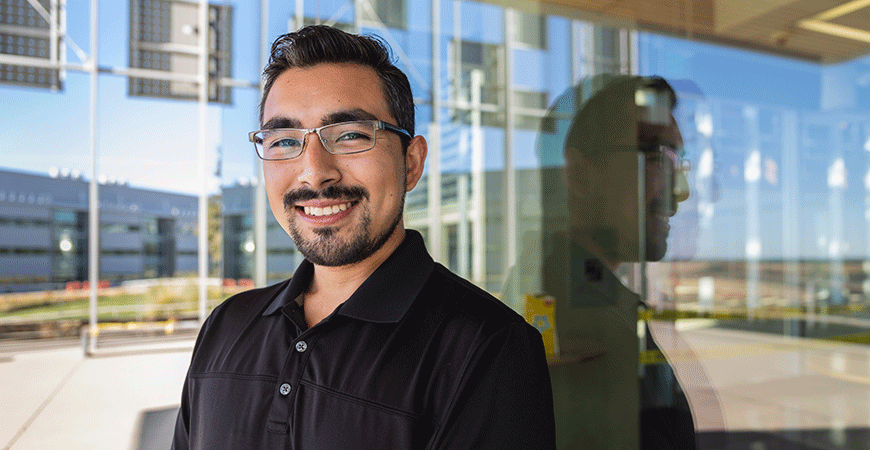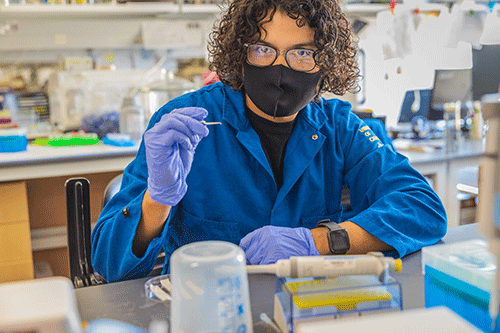
From graduate student Jose Zamora’s perspective, the CREST Center for Cellular and Biomolecular Machines (CCBM) has been a spectacular success.
“There is so much value to being part of the CCBM,” said Zamora, who began as an undergrad Scholar when the center opened and is now a graduate Fellow. He double majored in biology and physics and said that because of the CCBM, he has been able to explore both of his interests and learn about many other subjects. “I was hooked by the research. Joining the lab changed my life.”
Now Zamora is a cardiovascular tissue engineer in Professor Kara McCloskey ’s lab and is considering a career in industry, but on the research end.
The CCBM launched five years ago with funding from the National Science Foundation (NSF). The $5 million, five-year grant was awarded to UC Merced in 2016 under the leadership of professors Victor Muñoz, Ajay Gopinathan, Sayantani Ghosh and McCloskey. Co-directors Muñoz and Gopinathan independently considered starting centers but found so many overlapping ideas, they decided to collaborate. The Center’s scientific purpose is to accelerate research into how biological matter such as proteins or cells come together to perform specific tasks, effectively behaving as machines.
That’s a laudable goal, but the founding faculty members had more than tiny machines in mind.
They’re driven to ensure student success. They designed the center to give students an experience like no other: Expose them to in-depth interdisciplinary research and help them prepare for their futures.
So far, 49 of 61 CREST Scholars slots for undergraduates, or 80 percent, have gone to women and other underrepresented students. Many of those Scholars have gone into industry, including biomedical research facilities such as Abbott Laboratories and the Chan Zuckerberg Biohub. Others have gone on to graduate school at prestigious universities such as UC Berkeley, Stanford, Northwestern, Georgia Tech and UCSF. Three recent participants have earned NSF Graduate Research Fellowships.
And UC Merced graduate students who are part of the CCBM are being recognized for their work by becoming lead authors on publications and winning awards at conferences, as well as finding attractive positions in industry and academia upon completion of their degrees.
The Center offers its affiliated students multiple training sessions in research and professional and career development; opportunities to work with project scientists; participation in center workshops, meetings, and events; and avenues for each student to develop their leadership skills as they mentor other students.
The Center considers Bobcats-to-be, too, conducting extensive outreach to younger students throughout the region, helping area science teachers and offering lectures and other learning sessions for the public.
Now, as the CCBM awaits approval on its second round of support, the plan is to give more students these kinds of opportunities.
“It is vital to us that we are training students at all levels in a multi-disciplinary environment,” Gopinathan said. “To tackle tomorrow’s problems, we need a team-science approach bringing together multiple tools from different disciplines.”

Interdisciplinary Research and Training
The founding faculty designed a center with three main research thrusts, Muñoz explained in a recent presentation:
- Proteins as biomolecular machines, focusing on designing and characterizing nanoscale instruments based on protein molecules;
- Macromolecular assemblies and hybrid devices that combine the benefits of synthetic and biological materials for functional devices; and
- Cellular and multicellular systems such as tissue and bacterial swarms, differentiating tissue, bacterial movement and cellular imaging
“To get the grant, we needed to tell a cohesive story. We put together a team of researchers with interesting projects,” Gopinathan said, “and weaving them together has given us a lot of really interesting collaborations.”
Each thrust is led by a faculty member. Muñoz is a bioengineer and oversees biomolecular machines; McCloskey, in materials science and engineering, leads cellular and multicellular systems. Both are with the School of Engineering. Gopinathan leads the macromolecular assemblies thrust, and he and Ghosh are both physicists in the School of Natural Sciences. Gopinathan and Muñoz oversee the center overall, while Gopinathan and Ghosh lead graduate and undergraduate education, and CCBM Executive Director Carrie Kouadio leads center administration and outreach. The group is dedicated to increasing diversity in the science, technology, engineering and math (STEM) fields and to training the next generations of researchers, as well as building collaborations around complex research challenges.
The CCBM started with about a dozen faculty affiliates and has grown to include nearly 30 — about a 10th of the entire faculty. One of the missions has been to increase the campus’s instrumentation and computational resources, and the original grant along with campus support has allowed faculty to purchase mass spectrometry equipment as well as expanding computational capacity with new clusters and workstations.
Gopinathan said he’s proud of what the center brings to UC Merced.
“I think we’ve had a huge impact on the campus, not just because we’ve expanded research capability, but because we’ve built a community of collaborative, innovative people,” he said.
The center has received $1 million a year from the original grant and has used some of that money to seed faculty projects. The grants help researchers access larger outside funding pools from such agencies as the NSF and the National Institutes of Health. UC Merced, through center faculty alone, has been awarded related research funding of more than $7 million since May 2020. Most recently, center faculty led by Gopinathan, Muñoz and Andy LiWang received a National Institutes of Health G-RISE training grant for five years, which synergizes with the center’s research focus and will support 12 graduate students a year, Kouadio said. Center faculty have recently received prestigious awards, including professors Bin Liu, Arvind Gopinath and Daniel Beller having received NSF CAREER awards and Shahar Sukenik receiving a MIRA Award. Faculty have also won prestigious national honors such as election as Fellows of the American Physical Society (Gopinathan) and the American Academy of Microbiology (LiWang).
Independent evaluator, Professor Ayesha Boyce from the University of North Carolina at Greensboro has assessed CCBM programs and training for the past four years. She has nothing but praise for the center, listing research excellence, the authorship of articles in many top-tier journals, and the facilitation of unique collaborations as some of the major accomplishments. Center faculty have published more than 100 articles related to center research, with the majority in peer-reviewed journals.
The most outwardly visible successes, however, have been in education, training and outreach.
Each semester, the center takes applications from undergraduates and names between 12 and 16 CREST Scholars. Center faculty nominate grad students to become CCBM Fellows, and five to eight are accepted each semester. They receive stipends so they don’t have to work as teaching assistants during their fellowships and can focus entirely on their research, coursework and mentoring undergraduates.
“We try to reach a broad range of students,” McCloskey said. The center faculty have developed new courses and offer summer training workshops in which students learn research techniques. Some multicampus courses let Bobcats study with students at MIT, University of Pennsylvania and other schools across the country. There are virtual learning sessions, guest speakers, meetings and conferences and internship opportunities for students. Because of the faculty collaborations within CCBM, students often work with both experimentalists and theoreticians. Students at all levels have mentors, whether they are faculty, project scientists or other students.
“All of our students get a lot of feedback,” McCloskey said. “They love that, and the training sessions — they want more of those.”

Alumni, Outreach and the Next Generations
The positive feedback goes both ways. One of the tasks Boyce undertakes each year is surveying students of all ages — from K-12 through undergraduate and graduate students — who have participated in CCBM activities and programs such as the summer research experiences, as well as area teachers and members of the public who have attended learning sessions.
“The number of outreach activities is unique compared to other, similarly funded centers I evaluate,” Boyce said.
“Our center is committed to providing high-quality outreach opportunities to the local community and beyond that inspire and excite people of all ages,” Kouadio explained. “Through our center’s suite of engaging programs, UC Merced students, faculty, and staff expose students and community members to STEM concepts and skills.” One of those activities is the Science and Technology Enrichment Program (STEP) for high school students. Students are mentored by graduate students, scientists and faculty and they get experiences in university labs they couldn’t get anywhere else.
“The university is a whole different world for them,” Boyce said. “This is especially good for students who could be the first in their families to go to college.” She recalled a young Latina from a couple of years ago who told Boyce she was “totally transformed” by her participation, because it changed her understanding of what kind of education and careers are available to her. Students who participate in the outreach activities are motivated to stay in the STEM fields, too, she said.
Ghosh said she feels like now, five years in, the CCBM has built up its audience in the region.
“UC Merced is located here, in part, to increase the college-going rate in this area, and our goals has always been to offer opportunities to students who couldn’t get them elsewhere,” she said. “We’ve created a path and connections to higher education.”
The CCBM also works with regional Cal States to open up research opportunities for their students. Each summer, there’s a nine-week research program in which the students live on campus, get hands-on mentoring and the full lab experience.
“It helps them see research as an option for their futures,” Ghosh said.
Alumni such as Makiko Quint, who now works for a Silicon Valley semiconductor company called KLA, are quite sure the CCBM had a huge effect on their lives. She was part of the CCBM from its beginning. She studied liquid crystals with Ghosh and Professor Linda Hirst and developed a way to make liquid-crystal nano shells that could be used to deliver medicine inside the body — a process for which she has filed a patent application.
“The CCBM helped me a lot,” Quint said. “I was a Scholar several times, they helped fund some of my research, which was expensive, and I learned a lot of techniques. By the end, I was collaborating with Stanford bioengineers.”
One of the most important skills she learned from her time with the CCBM was the ability to communicate with other scientists from different disciplines. Her job involves working with many other teams, including software engineers. If not for the coding training she received at UC Merced, she said, she’d have a much harder time understanding what problems she faces, who to go to for help and how to tell them what she needs.
“The best thing about the CCBM is that it doesn’t have any boundaries,” Quint said. “If you are motivated, you can do anything.”
Lorena Anderson

Senior Writer and Public Information Representative
Office: (209) 228-4406
Mobile: (209) 201-6255






